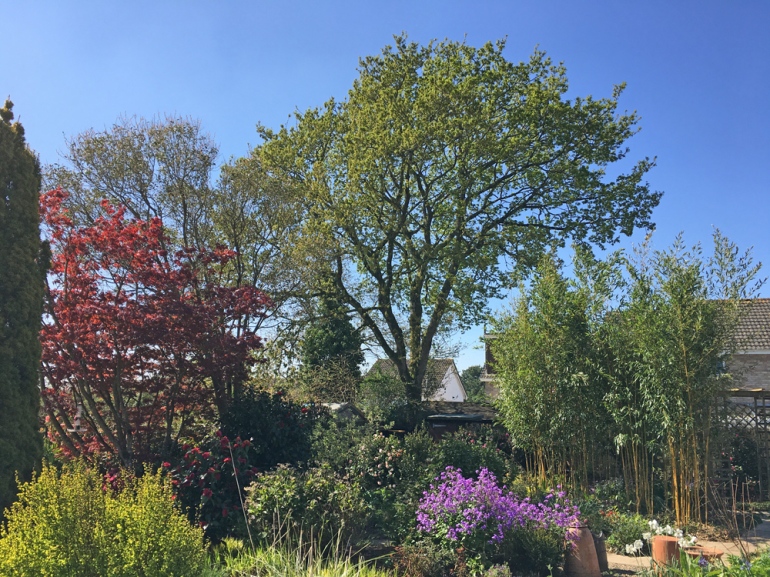
Somewhere in the hidden recesses of my memory is something about William Robinson and the need for every gardener to set aside an acre or so of their garden for woodland.
I have tried, but with a garden of around one eighth of an acre in total, I have failed. My woodland consists of the area shaded by one tree, an oak which casts a moving shadow over about a quarter of the garden for at least part of the day. It is supported by a number of large and smaller shrubs, some of which create useful shade when the sun is lower in the morning and evening, as well as creating a sense of enclosure.
It was only when I read Isabella Tree’s book ‘Wilding’ that I learned that Oak is not naturally a woodland tree at all and that the idea that the natural state of the UK is closed forest canopy from shore to shore is just plain wrong. It becomes one because of the lack of large grazing animals that would clear large open spaces leaving Oaks well spaced in the landscape. So it transpires that my solitary tree is a natural feature in an unnatural environment. I’m guessing that many of the plants we think of as woodlanders are also things that are growing in woodland now because it’s as close as they can get to their particular niche in a more complex landscape.
In that more complex landscape plants that prefer shade could find it in pockets of woodland, in the shade of a single tree or tucked under the northern side of a bush. Many of the plants in this category are ephemerals that grab the light available below deciduous trees in the months before they come into leaf in the spring. They then die down and disappear until early the following year. Wood anemones, bluebells and Erythroniums are good examples. They don’t normally die away leaving bare ground but get followed by other plants. The trees may be in leaf but the days are longer and the light brighter above the trees so perhaps the amount of light reaching the woodland floor is not so different.
I am trying to emulate this situation, with later emerging plants filling the space left by the early ones. The year starts with wood anemones, primulas, bluebells, Corydalis. These die down to be followed Begonia grandis, Roscoea, Bletilla and Impatiens amongst others.
Many plants come up in spring and stay the course, flowering in spring then ripening their fruits for the autumn. Polygonatum, Maianthemum, Disporum, Uvularia, Convallaria and a host of ferns covers most bases though there are others.
On a small scale you can micro-manage these contrived plant associations in a way you couldn’t on a larger canvas. I can snip things back, dig bits out, move things around until I arrive at some sort of equilibrium. I have to be vigilant, sometimes ruthless, but I find it fascinating and rewarding.
Thanks for sharing Jim!
LikeLiked by 1 person
Lovely! Thank you Jim.
LikeLiked by 1 person
Brilliant Jim. I had to get rid of my holboellia as it was so vigorous it was strangling lots of plants. Yours has much better flowers than mine ever had-I might be tempted again. John M.
LikeLike
I’ve seen pictures of even better flower forms, must be very variable. It is a bit of a beast.
LikeLike
Well I for one think your ‘Woodland’ is beautiful. I wish I had space for an oak tree……………….
LikeLiked by 1 person
What a delightful tour of your garden! Thank you for the video and the narration.
LikeLiked by 1 person
Seriously, I had more space for gardening when I lived on a small but nicely flat suburban parcel in town than I have in many acres in the forest. There is very little flat space here, and the forest it too thick for gardening. The redwoods are so tall, that they shade huge areas. I think that some of them shade gardens in Nevada. You can see for yourself it you look to the west-southwest. I should get an arborist out there to knock out those pesky satellites. If the moon doesn’t rise, you know where it got stuck.
LikeLike
I think if I lived in a forest I might spend most of my time hiking through it, at least if it were penetrable. It’s all about the trees in such places. I’m not well travelled but I would rate visiting the giant redwoods in the Sierra Nevada and the New Zealand Kauri forest remnants among the best places I’ve ever been. Cathedral Grove on Vancouver Island too.
LikeLiked by 1 person
Giant redwoods are even bigger, although not quite as tall. When I am in Los Angeles, I notice that the front yards of some of the homes are not as wide as the trunks of just one giant sequoia.
LikeLike
I hope you’re not saying they have redwoods in them!
LikeLiked by 1 person
Some do. They are uncommon in Southern California, but I sometimes see redwoods in home gardens, including one that I procured myself from here. They will push the houses that they are next to aside in 2000 years or so.
LikeLiked by 1 person
You must try the books on woodland and landscape by Oliver Rackham, Botany Research Fellow, Cambridge University.
Re gardens was it Lionel de Rothschild lecturing RHS? “No garden, however small, should have less than 4 acres of rough woodland” Er, yes, I often quote!
LikeLike
I will look up Oliver Rackham, the name rings a bell. Four acres of woodland was it? My failure just grew, starting with failing to be born a Rothschild.
LikeLike